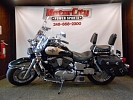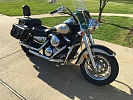2000 KAWASAKI 1500 VULCAN CLASSIC FI -- 2151 ORIGINAL MILES -- ORIGINAL OWNER
2000 Kawasaki Vulcan
| Price: | US $3,795.00 |
| Item location: | Huntingtown, Maryland, United States |
| Make: | Kawasaki |
| Model: | Vulcan |
| SubModel: | CLASSIC FI |
| Type: | Cruiser |
| Year: | 2000 |
| Mileage: | 2,151 |
| VIN: | JKBVNAN15YA002028 |
| Color: | Candy Cardinal Red/Pearl Gentry Gray (LOOKS TAN) |
| Engine size: | 1,500 |
| Vehicle Title: | Clear |
| Contact seller: | Contact form |
ORIGINAL OWNER AND PURCHASED NEW. IN 2000 KAWASAKI MADE MAJOR CHANGES INCLUDING FUEL INJECTION AND DIGITAL ELECTRONICS. THE CHANGES MADE THE VULCAN CLASSIC FUEL INJECTED MOTORCYCLE AN AMAZING BIKE BOTH IN APPEARANCE AND PERFORMANCE. THIS MOTORCYCLE HAS BEEN GARAGED UNDER COVERED SINCE NEW. ONLY 2151 ORIGINAL MILES. BIKE IS ORIGINAL AND STOCK EXCEPT FOR VANCE AND HYNES PIPES. JUST HAD PROFESSIONAL MOTORCYCLE MECHANIC DO COMPLETE CHECK UP AND TEST RIDE. HE ALSO PERFORMED WORK THAT WAS DONE. OIL AND FILTER WERE CHANGED. NEW BATTERY WAS INSTALLED. NEW PLUGS INSTALLED. BIKE IS READY TO RIDE AND LOOKS GREAT. JUST HAD DETAILED ON 06/22/2015. COST OF WORK AND DETAILING $750.I AM 67 YEARS OLD AND DO NOT INTEND ON GETTING NEW TAGS. THIS IS THE ONLY REASON FOR SALE. IF YOU ARE NOT FAMILIAR WITH THE KAWASAKI 1500 VULCAN CLASSIC PLEASE SEE SPECIFICATIONS AND READ THE ARTICLE BELOW. THE BIKE FOR SALE IS SAME COLOR AND IDENTICAL TO PICTURES IN ARTICLE EXCEPT FOR THE VANCE AND HYNES PIPES I HAD INSTALLED.FELL FREE TO ASK QUESTIONS. THANK YOU FOR YOUR INTEREST.Specifications Engine type: 4-stroke V-Twin SOHC 8-valve Displacement 1470cc Bore x Stroke: 102.0 x 90.0mm Cooling: Liquid Induction: Mitsubishi Digital Fuel Injection with dual 36mm throttle bodies Ignition: Digital with Throttle Responsive Ignition Control (K-TRIC) Transmission: 5-speed Frame: High tensile steel double cradle Rake/trail: 32 degrees/6.4 in. Suspension front: 41mm hydraulic fork Suspension rear: Dual hydraulic shocks 5-way preload adjustable Wheel travel front: 5.9 in. Wheel travel rear: 3.7 in. Tire front: 130/90x16 Tire rear: 150/80x16 Brakes front/rear: Dual hydraulic disc/ Single disc Overall length: 98.6 in. Overall width: 39.2 in. Overall height: 44.9 in. Ground clearance: 4.9 in. Seat height: 27.6 in. Dry weight: 659 lbs Fuel capacity: 5.0 gal. Wheelbase: 65.6 in. Color: Candy Cardinal Red/Pearl Gentry GrayARTICLE FROM INTERNET Daytona Beach Florida March 16 2000-- Kawasaki cheats! It's a plain and simple fact really; you can't invite the press to Daytona Beach Florida to ride new motorcycles in the fun and sun of Bike Week 2000 and expect folks to say much of anything negative except perhaps that Florida is pretty darn flat.That said we can't complain about the motorcycles we rode. When first we saw Kawasaki's new Vulcan 1500 Classic Fi it was hard not to smile knowing we'd spend the better part of the day traversing roughly 160 miles of the twistiest roads in Florida the vast majority of which would be considered arrow-straight anywhere north of the Panhandle or west of Denver.
Although the main selling point of the new Fi Vulcan is its fuel-injection system that is supposed to improve power and throttle response (that's why it's called the ClassicFi) Kawasaki has made a few other changes. The end result is a bike that Kawasaki hopes will travel longer stronger and look better than its carbureted brother.The new Vulcan 1500 Classic Fi. Since cruiser riders appreciate power as much as the next guy Kawasaki installed new pistons that bump compression from 8.6:1 to 9.0:1 for a reported 2hp increase along with one additional foot-pound of torque. These changes necessitate the use of at least 90-octane fuel. The cam timing has also been tweaked to improve power and keep things smooth and quiet while the piston pin offset was reduced from 2.0mm to 1.0mm to minimize top-end noise.Controlling internal movements of the Classic Fi is a new ECU that uses a 16-bit processor and has fuel mapping specifically designed for it. When compared to the carbureted version and combined with the new injectors and other changes the new ECU is supposed to improve cruising range and gas mileage as well as power.The ECU measures water temperature intake-air pressure and temperature atmospheric pressure and throttle-opening to vary the amount of fuel squirted into each cylinder to ensure the correct fuel/air ratio for all conditions. When the engine load is light the ECU focuses mainly on engine intake pressure and speed to determine the correct amount of fuel needed. Under a mid-to-heavy load the fuel amount is calculated from throttle opening and engine speed. This is a far efficient design than when the surrounding conditions were monitored only at start-up."On the tip of each injector are four nozzles with two aimed directly at each intake valve for better fuel atomization."Fuel injection and a new ECU add a few more ponies and increase gas mileage and cruising range. The throttle bodies are dual 36mm items that use one injector per cylinder with separate intake tracts. On the tip of each injector are four nozzles with two aimed directly at each intake valve for better fuel atomization. To get rid of burned gasses a new exhaust pipe features a 2.2mm larger inner diameter (up to 35mm) and utilizes a catalyzer in the collector to allow for maximum power output while still retaining acceptable emission levels.The FI system incorporates an auto-choke system but the bike still retains a fast-idle knob. The ECU continuously monitors water temperature and adjusts the idle speed control valves to warm the engine quickly in cooler climates.However there is more to the new Fi Vulcan than the fuel-injection system. For example the seemingly insignificant change from a cable-driven speedometer to an electric unit provided a huge increase in cruising mileage. By eliminating the deep housing the speedometer needed and the cable that passed through the bottom of the tank Kawasaki found enough room for almost an extra gallon of fuel (from 4.2 gallons to 5.0 gallons) in the same space. The new speedometer features a digital odometer tripmeter and clock and the tank is now seamless eliminating the unsightly external flanges.New fuel tank is seamless and the capacity is increased by 0.8 gallons. The frame is now more rigid thanks to large main frame pipes that are 42.7mm in diameter (up from 34mm) a larger diameter steering-head pipe bearings and stronger gussets. The head pipe has also been moved forward 35mm to decrease fork offset to 25mm (from 60mm) which increased trail from 4.8 inches to 6.3 inches.The rear brake caliper is now a dual-piston unit that utilizes larger pads for more braking power. The rider's floorboards have been moved aft 65mm for a more upright seating position and the front brake and clutch levers are wider 5-way adjustable items instead of the 4-way levers found on the carbureted Classic.Other changes include an upgrade from a 12V-14Ah battery to a 12V-18Ah unit (while retaining the same physical size) a low-fuel warning light replaces the petcock and a new multi-pane headlight provides a brighter more concentrated beam. A new self-canceling turn-signal system is now used and the spokes have a special coating on them to make sure they stay shiny longer.Florida FrolickingA sunny Florida day during the middle of Bike Week 2000. Even with all the chassis tweaks Kawasaki tells us that they upgraded the Vulcan Classic to Fi status to give it more power and better fuel economy. So why then should somebody purchase the Fi model which makes only 2hp more than the carbureted version yet sells for $800.00 more?Although there has been only a minor increase in the power output of the Classic Fi we prefer it over the carbureted Classic. Why? First the chassis changes offer a more solid and sporty ride. Also the new fuel-injection system cleans up throttle response and when you install a set of loud and chrome exhaust pipes there's no need to worry about re-jetting -- the new Fi system should do it all without you ever having to even look at the owner's manual knock wood.The added fuel capacity is also a noteworthy change since the cruising range is now in the neighborhood of 160 miles compared to 105 miles on the carbureted Classic. Once the reserve light comes on there's still enough fuel for another 30-plus miles so a single tankful should last all day. Also the more upright riding position and comfortable seat make this additional cruising range and fuel mileage all the more inviting to access.The suspension on the Fi is better than what's commonly found on other cruisers. Most cruisers have an under-damped feeling that tends to feel harsh over the small pavement irregularities. The Vulcan Fi surprised everyone with its soft yet well-sprung ride that smoothed out most all of the annoying little bumps on Florida's backroads.Look closely. There's only one real melon-head in this photo. Minime is everywhere...Though the front suspension is non-adjustable (very few cruisers are adjustable) the 5-way preload adjustable rear shock was easy to adjust even while riding and with each change we felt a difference. The ride-height didn't seem to increase any since we would still drag the floorboards at approximately the same lean angles but the ground clearance was about on par with what is offered by other manufacturers: it's notably better than that of the Harley-Davidson Fat Boy and about equal to that of the Yamaha Road Star.We had the chance to ride a few of Kawasaki's custom Vulcans with modifications such as high-compression pistons stiffer valve springs more aggressive cams drag pipes and even turbos. Kawasaki motorcycles from Ninja's to Drifters are known for their engines and there are lot of tweaks that can reliably be done reliably to the Vulcan 1500 Classic motor and the Fi makes it all a less daunting proposition."It's not only the newest iteration of one of their best-selling motorcycles it's also the platform for a number of models to come."Will it make you Smile? Kawasaki's newest variation on its Vulcan line this Classic Fi is more than just their latest and greatest up scale cruiser. It's not only the newest iteration of one of their best-selling motorcycles it's also the platform for a number of models to come.We look forward to getting our hands on one of these new Vulcan 1500 Classic Fi models so we can compare it against similar bikes in a heads-up contest of big-bore cruisers. Still in the brief time we spent on the bike in and around Daytona Beach we must admit we smiled.Also published at eBay.com


